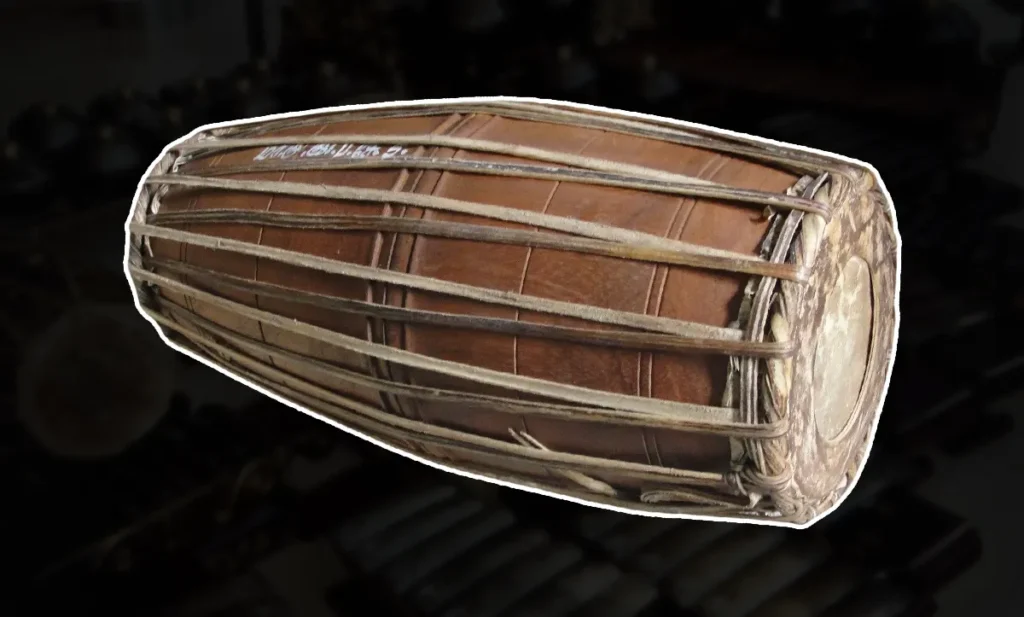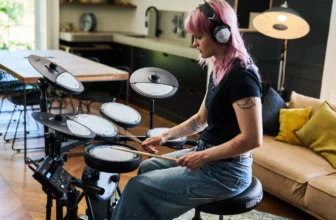

The rhythms of South Asian percussion instruments have been an integral part of the region’s music and cultural traditions for centuries. From the traditional dhol, tabla, mridangam, and ghatam to the more recent electronic tabla and drum machines, these instruments have played a vital role in shaping the soundscape of South Asian music.
With such a rich tapestry of diverse styles, techniques, and influences reflecting the region’s cultural and historical connections with neighboring countries and beyond, it’s hard to condense such diversity into a single article.
However, today, we will do our best to take a closer look at the evolution of South Asian percussion, tracing its roots from ancient times to the present day and exploring some of the most popular instruments in the culture.
Ancient Origins of South Asian Percussion
The origins of South Asian percussion can be traced back to the ancient Vedic period, which lasted from around 1500 BCE to 500 BCE.
During this time, music was an essential part of religious and social rituals, and percussion instruments played a central role in these performances. The earliest percussion instruments included the mridangam, a two-headed drum made of clay or wood, and the damaru, a small, hourglass-shaped drum.
Over time, these instruments were refined and developed, with new techniques and styles emerging as musicians experimented with different rhythms and sounds. The influence of neighboring regions such as Persia, Central Asia, and China also contributed to the evolution of South Asian percussion, leading to the development of new instruments and styles of playing.
Let’s take a look at some of the most popular south Asian percussion instruments.
Mridangam

The mridangam is one of the oldest South Asian instruments, dating back more than 2,000 years ago.
This double-headed drum originated in South India and is made of a hollowed-out piece of wood, usually jackfruit or Indian neem tree, and has two different drumheads of different sizes on either end.
The larger head, sometimes called the “bass head,” is traditionally made of cowhide and produces a deep, resonant sound. In comparison, the smaller head, often called the “treble head,” is traditionally made of goat skin and creates a sharper, higher-pitched sound.
The drum is played with the fingers and palms of both hands, and the player will use different techniques to produce a wide range of rhythms and melodies. Many consider the mridangam one of the most essential percussion instruments in South Indian classical music, especially with its long and rich history dating back to ancient times.
Ghatam

The Ghatam is another percussion instrument with origins in South India. It takes the form of a clay pot made of a unique mixture of clay and other materials, such as brass or copper filings, giving it a distinctive metallic sound.
The pot is usually about a foot in height and has a narrow mouth traditionally covered with animal skin, such as goat or lizard skin, which is stretched over the opening and secured in place with a rope.
To play the ghatam, players will strike the pot with the fingers and palms of both hands, producing a range of sounds and rhythms. You’ll often hear the ghatam played in ensemble performances and other percussion instruments like the mridangam and kanjira.
Dhol

The Dhol is similar to the mridangam in that it is a double-headed drum widely used in South Asian music, particularly in traditional folk music from the Punjab region of India and Pakistan.
This large drum is typically made of either mango or sheesham wood and has two drumheads of different sizes on either end. The larger head, often called the “bass head,” is made of animal skin, such as goat or buffalo skin, while the smaller head, often called the “treble head,” is made of thinner animal skin to produce a higher-pitched sound.
The dhol is played with two wooden sticks, called the “dagga,” and is often accompanied by other instruments such as the harmonium, tabla, and flute. Beyond classical or traditional genres, you can hear the Dhol throughout many modern popular music genres like bhangra and Bollywood music.
Tabla

If you know anything about Indian music, you likely know about tabla.
The tabla is an instrument composed of a pair of drums that originated in North India and is widely used in classical, devotional, and popular music. The drum pair consists of a small, wooden drum called the “dayan” or “tabla,” and a larger, cylindrical drum called the “bayan” or “duggi.”
Tablas are often made of rosewood or sheesham wood, and the drumheads are traditionally made of animal skin, such as goat or cow skin, which is tightened and tuned using a set of tuning pegs.
Many consider the tabla one of the most sophisticated percussion instruments in the world, thanks to its ability to produce a wide range of tones and intricate rhythms and patterns. It is often used in ensemble performances along with other instruments, such as the sitar, sarod, and bansuri.
Kanjira

The Kanjira, or the Ganjira, is a percussion instrument commonly used in South Indian classical music and dance performances.
This small, handheld drum is wood and has a single drumhead, often made of goat or lizard skin. The drumhead is stretched over the wooden frame using a tuning paste made of rice flour and water, which is applied to the rim of the drumhead.
To play the kanjira, you can strike the drumhead with the fingers and palm of one hand while the other holds the instrument and applies pressure to change the pitch and tone of the sound.
The kanjira is instantly recognizable, thanks to its unique, buzzing sound, which is produced by the small metal cymbals or “jingles” attached to the drumhead’s underside. You’ll often hear it in ensemble performances and other percussion instruments such as the mridangam, ghatam, and tabla.
South Asian Regional Rhythmic Styles
There are so many regional rhythmic styles associated with South Asian percussion, each with its own unique flavor and character. While it’d be impossible to showcase them all in a few paragraphs, here are some of the most popular:
Carnatic: Complex patterns and a strong emphasis on improvisation characterize this rhythmic style from South India. In Carnatic music, you’ll often hear instruments like the mridangam, ghatam, and kanjira.
Hindustani: This rhythmic style from North India is known for using the tabla and pakhawaj drums. Hindustani rhythms are typically based on a cycle of beats known as taal and can be complex and intricate.
Bhangra: This rhythmic style comes from the Punjab region of India and is characterized by energetic beats and lively dance rhythms. You’ll often hear the dhol used as the primary percussion instrument in Bhangra music.
Of course, these are just a few examples of the many regional rhythmic styles in South Asian percussion music, though I highly recommend exploring them as a jumping-off point!
Famous South Asian Percussionists
As such a large portion of Asia, many famous South Asian percussionists have contributed to developing and popularizing percussion music in the region and worldwide. Let’s take a look at some of the most iconic names in South Asian percussion:
Zakir Hussain: This world-renowned Indian tabla player has played a vital role in popularizing Indian classical music worldwide. Hussain began playing the tabla at a young age and trained under his father and other prominent musicians. He eventually joined and performed with many famous musicians and ensembles, including Ravi Shankar, John McLaughlin, Mickey Hart, and Yo-Yo Ma. He has also won several Grammys throughout his professional career.
Vikku Vinayakram: Vikku is considered by many to be one of the greatest ghatam players of all time. This legendary percussionist from South India is known for his mastery of the ghatam and has won several awards for his contributions to Indian music, including the Padma Shri and Padma Bhushan, among the highest civilian honors in India.
Alla Rakha: Born as A. R. Qureshi, Alla Rakha was a world-renowned Indian tabla player known for his virtuosic playing and contributions to developing and popularizing Indian classical music. Rakha was a frequent collaborator of Ravi Shankar, and the two musicians performed together on many occasions, including the famous Concert for Bangladesh in 1971. He collaborated with several Western musicians, including George Harrison, Joan Baez, and Mickey Hart.
From Clay to Skin
The history of South Asian percussion offers a rich and diverse story that reflects the region’s deep musical traditions and cultural heritage.
From the ancient origins of the mridangam and ghatam to the complex rhythms of the tabla and dhol, South Asian percussion has evolved and flourished over centuries, drawing on crossing influences and inspiring generations of musicians around the world.
While the instruments and styles of South Asian percussion may vary, they are all rooted in a deep respect for the power of rhythm and a desire to create music that transcends language and culture.
As South Asian music continues to gain popularity and influence worldwide, the legacy of the region’s percussionists will continue to inspire and captivate audiences for generations to come.
Have fun exploring the distinct sounds and rhythms of South Asia!




